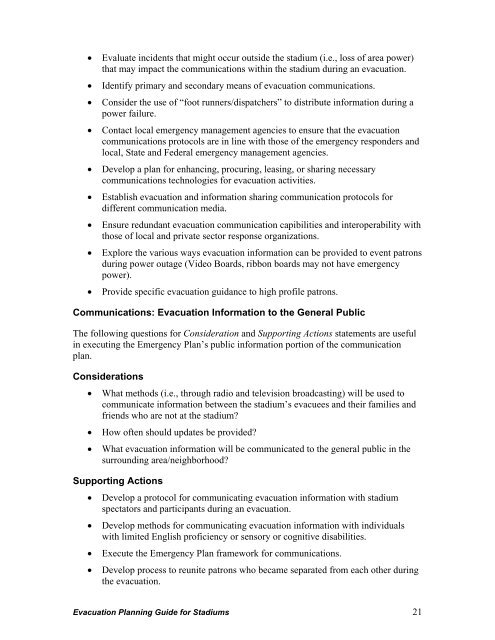Evacuation Planning Guide for Stadiums
Evacuation Planning Guide for Stadiums
Evacuation Planning Guide for Stadiums
You also want an ePaper? Increase the reach of your titles
YUMPU automatically turns print PDFs into web optimized ePapers that Google loves.
• Evaluate incidents that might occur outside the stadium (i.e., loss of area power)<br />
that may impact the communications within the stadium during an evacuation.<br />
• Identify primary and secondary means of evacuation communications.<br />
• Consider the use of “foot runners/dispatchers” to distribute in<strong>for</strong>mation during a<br />
power failure.<br />
• Contact local emergency management agencies to ensure that the evacuation<br />
communications protocols are in line with those of the emergency responders and<br />
local, State and Federal emergency management agencies.<br />
• Develop a plan <strong>for</strong> enhancing, procuring, leasing, or sharing necessary<br />
communications technologies <strong>for</strong> evacuation activities.<br />
• Establish evacuation and in<strong>for</strong>mation sharing communication protocols <strong>for</strong><br />
different communication media.<br />
• Ensure redundant evacuation communication capibilities and interoperability with<br />
those of local and private sector response organizations.<br />
• Explore the various ways evacuation in<strong>for</strong>mation can be provided to event patrons<br />
during power outage (Video Boards, ribbon boards may not have emergency<br />
power).<br />
• Provide specific evacuation guidance to high profile patrons.<br />
Communications: <strong>Evacuation</strong> In<strong>for</strong>mation to the General Public<br />
The following questions <strong>for</strong> Consideration and Supporting Actions statements are useful<br />
in executing the Emergency Plan’s public in<strong>for</strong>mation portion of the communication<br />
plan.<br />
Considerations<br />
• What methods (i.e., through radio and television broadcasting) will be used to<br />
communicate in<strong>for</strong>mation between the stadium’s evacuees and their families and<br />
friends who are not at the stadium?<br />
• How often should updates be provided?<br />
• What evacuation in<strong>for</strong>mation will be communicated to the general public in the<br />
surrounding area/neighborhood?<br />
Supporting Actions<br />
• Develop a protocol <strong>for</strong> communicating evacuation in<strong>for</strong>mation with stadium<br />
spectators and participants during an evacuation.<br />
• Develop methods <strong>for</strong> communicating evacuation in<strong>for</strong>mation with individuals<br />
with limited English proficiency or sensory or cognitive disabilities.<br />
• Execute the Emergency Plan framework <strong>for</strong> communications.<br />
• Develop process to reunite patrons who became separated from each other during<br />
the evacuation.<br />
<strong>Evacuation</strong> <strong>Planning</strong> <strong>Guide</strong> <strong>for</strong> <strong>Stadiums</strong> 21


